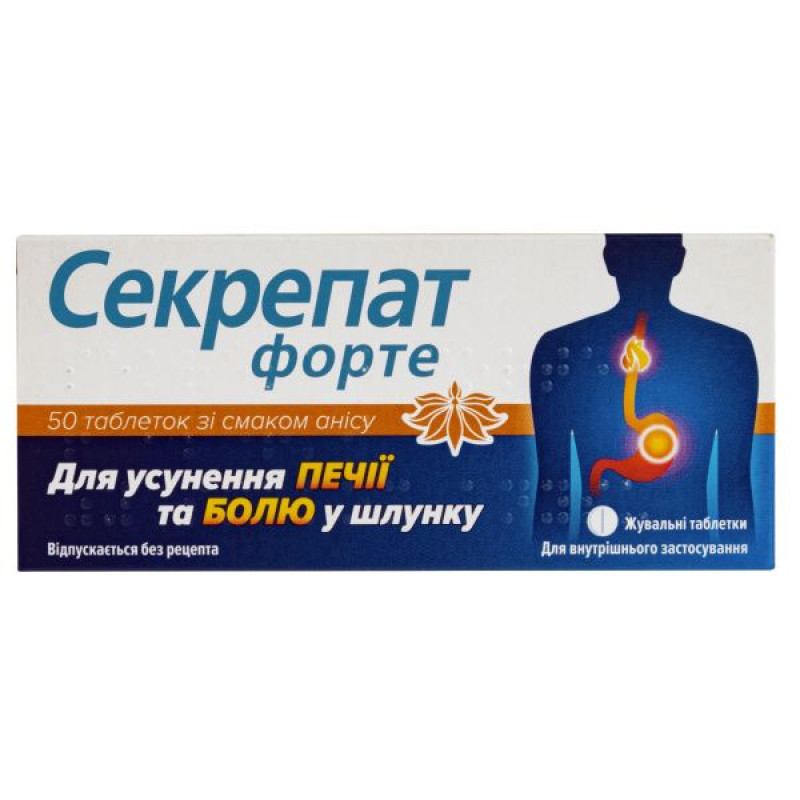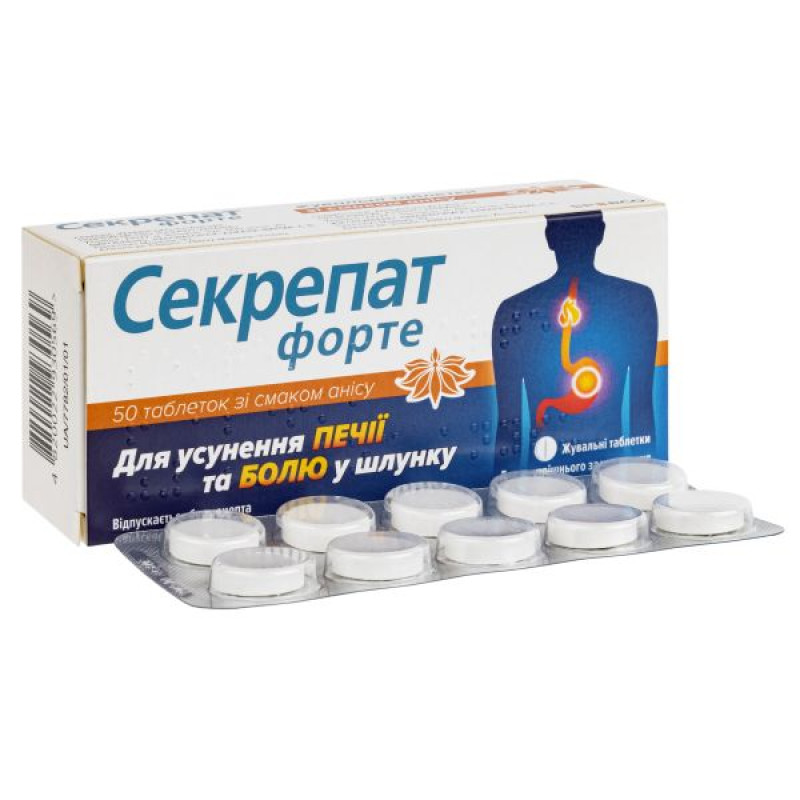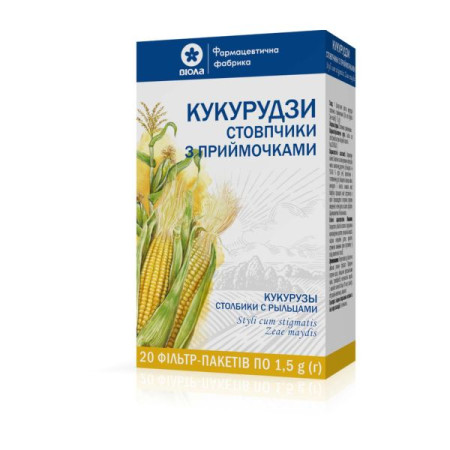Secret Forte chewable tablets blister with anise flavor No. 50

Instructions for use Secretapate forte chewable tablets blister with anise flavor No. 50
Composition
active ingredient: dihydroxyaluminum aminoacetate; aluminum hydroxide, dry gel; calcium carbonate; hydrated magnesium trisilicate;
1 tablet contains: dihydroxyaluminum aminoacetate – 400 mg; aluminum hydroxide, dry gel – 100 mg; calcium carbonate – 150 mg; hydrated magnesium trisilicate – 50 mg;
excipients: glycine, magnesium stearate, essence (anise or mint), polysorbate 80, sodium saccharin, sucrose
Dosage form
Chewable tablets with anise or mint flavor.
Main physicochemical properties: almost white tablets, round in shape with a flat base, with a mint or anise flavor.
Pharmacotherapeutic group
Antacids. Combined preparations and complex compounds of aluminum, calcium and magnesium.
ATX code A02A D01.
Pharmacological properties
Pharmacodynamics.
Secret forte is a combined balanced antacid medicine for eliminating heartburn and stomach pain. The reduction of pain syndrome and heartburn is provided by the effects of the components that make up the drug.
Calcium carbonate acts within a few minutes after ingestion, neutralizing hydrochloric acid.
Magnesium trisilicate, due to its floating effect, contributes to the formation of an antacid film on the surface of the gastric contents, which covers the wall of the esophagus during reflux. Aluminum salts (dihydroxyaluminum aminoacetate and aluminum hydroxide) in the composition of Secret forte have antacid, enveloping, adsorbing effects, maintaining pH around 4. Due to their buffer properties, they neutralize only excess hydrochloric acid, maintain physiological conditions of digestion and do not lead to secondary hypersecretion of gastric juice. The cytoprotective effect of aluminum salts is due to the ability to activate their own protective factors, in particular the synthesis of prostaglandins, which stimulate the secretion of mucus and bicarbonates in the gastric mucosa, which leads to the accumulation of epidermal growth factor in the defect area and scarring of ulcers.
During the neutralization process, carbon dioxide is not formed, flatulence does not occur, and, as a result, secondary hypersecretion does not occur.
Pharmacokinetics.
The drug acts locally. Only a small amount of aluminum compounds is absorbed, a little more - magnesium compounds, which are quickly excreted from the body with urine. As a result of neutralization of hydrochloric acid, aluminum and magnesium hydroxides are converted into chlorides and excreted from the body with feces.
Indication
For symptomatic treatment of pain syndrome and heartburn in diseases of the gastrointestinal tract, such as peptic ulcer of the stomach, duodenum, gastroesophageal reflux disease, dyspepsia, acute and chronic gastritis with increased or normal secretion. Irritation of the gastric mucosa caused by smoking or dietary disorders (consumption of alcohol, coffee, sweets, flour products, etc.). As a prophylactic agent for long-term use of nonsteroidal anti-inflammatory drugs, glucocorticoids and other ulcerogenic agents.
Contraindication
Hypersensitivity to the components of the drug; severe renal failure (creatinine clearance below 30 ml/min); nephrolithiasis caused by the deposition of calcium-containing stones; Alzheimer's disease; hypophosphatemia; habitual constipation, chronic diarrhea, severe abdominal pain of unspecified genesis; hypercalcemia and/or conditions leading to hypercalcemia; patient age up to 10 years.
Interaction with other medicinal products and other types of interactions
A 2-hour interval should be observed between taking Secret forte and the following medications: ethambutol, chloroquine, cyclines, diflunisal, diphosphonates, fexofenadine, sodium fluoride, glucocorticoid drugs (interaction with prednisolone and dexamethasone has been described), indomethacin, kayexalate, ketoconazole, lansoprazole, lincosamides, phenothiazine neuroleptics, penicillamine, phosphorus (supplements), thyroxine.
Secret forte reduces the absorption of certain drugs (tetracyclines, fluoroquinolones, isoniazid, naproxen, quinidine, cardiac glycosides (digoxin), histamine receptor blockers, adrenoblockers, iron preparations).
The drug increases the absorption of levodopa, acetylsalicylic acid and nalidixic acid.
Thiazide diuretics reduce urinary calcium excretion and increase serum calcium levels. Due to the increased risk of hypercalcemia, serum calcium levels should be monitored regularly during concomitant use of thiazide diuretics.
In case of simultaneous use with phosphates, fluorine compounds, levothyroxine and eltrombopag, the absorption of the latter is reduced.
Concomitant use of aluminum hydroxide and citrates may lead to increased aluminum levels, especially in patients with renal insufficiency.
Application features
If the symptoms do not disappear, partially persist or worsen after 10 days of treatment, it is necessary to conduct an examination to clarify their nature and review the treatment regimen. The course of treatment should not exceed 10 days. Patients should consult a doctor in case of: weight loss, difficulty swallowing and constant feeling of discomfort in the abdomen, digestive disorders that appeared for the first time, changes in the course of existing digestive disorders.
Aluminum hydroxide may cause constipation, and hydrated magnesium trisilicate may cause intestinal hypokinesia; use of this drug in high doses may cause or complicate intestinal obstruction and intestinal ileus, especially in patients at increased risk of such complications, such as patients with renal insufficiency or elderly patients.
Aluminum salts are generally poorly absorbed from the gastrointestinal tract, and therefore systemic effects in patients with normal renal function are rare. However, the use of excessive doses of the drug or prolonged use of the drug, or even the use of normal doses of the drug in patients whose diet is characterized by a low phosphorus content, can lead to a decrease in the phosphate content in the body, which is accompanied by increased bone resorption and the occurrence of hypercalciuria with an increased risk of osteomalacia (due to the binding of aluminum to phosphate).
Elevated plasma concentrations of both aluminum and magnesium may occur in patients with renal insufficiency. In such patients, prolonged use of high doses of aluminum and magnesium salts may lead to the development of encephalopathy, dementia, microcytic anemia, or worsen dialysis-induced osteomalacia.
Aluminum hydroxide may be dangerous for patients with porphyria who are receiving hemodialysis.
Calcium and magnesium salts should not be used in hypercalciuria. With caution, Secret forte is prescribed to patients with impaired renal function, especially those on dialysis, with metabolic disorders and patients on a low-phosphate diet, to reduce the risk of aluminum and magnesium intoxication and the development of hypophosphatemia. With prolonged use of the drug, it is necessary to monitor the level of aluminum, magnesium and calcium in the blood plasma. Long-term use of the drug in high doses may increase the risk of kidney stones.
Patients with hereditary diseases accompanied by fructose intolerance, glucose-galactose malabsorption or sucrose-isomaltase insufficiency should not use the drug due to the sucrose content.
Patients with diabetes should take into account that the drug contains sucrose.
Use during pregnancy or breastfeeding
During pregnancy, the use of the drug is possible on prescription and under the supervision of a doctor in cases where the expected benefit to the pregnant woman outweighs the potential risk to the fetus. It is necessary to take into account the content of aluminum and magnesium ions, which can affect transit in the gastrointestinal tract:
magnesium salts can cause diarrhea;
Aluminum salts can cause constipation and worsen constipation, which is often observed during pregnancy.
The presence of calcium in high doses used for a long time increases the risk of hypercalcemia with calcification of various organs, including the kidneys.
Prolonged use and overdose of this medicine should be avoided.
Pregnant women should avoid constant consumption of milk (1 liter contains up to 1.2 g of elemental calcium) and dairy products while using the drug to prevent excess calcium, which can lead to the so-called milk-alkali syndrome (Burnet syndrome), which is a rare but serious disease that requires medical attention.
If it is necessary to prescribe the drug during lactation, breastfeeding should be discontinued for the entire period of use of the drug.
Ability to influence reaction speed when driving vehicles or other mechanisms
Does not affect.
Method of administration and doses
The drug is administered orally. The tablets are slowly dissolved or chewed. Adults are prescribed 1–2 tablets 4–6 times a day, the last time immediately before bedtime. The drug is recommended to be taken 1–1.5 hours after meals. The course of treatment is 3–4 weeks. For heartburn and stomach pain, the drug is taken in the same dose, but regardless of meals (if necessary). For prophylactic purposes, to protect the mucous membrane from the irritating effects of medications, 1–2 tablets are taken 2 hours before taking other medications. Children aged 10 to 18 years are prescribed half the adult dose. The maximum daily dose for adults is 12 tablets.
Children
If indicated, the drug is used in children over 10 years of age.
Overdose
The drug in high doses, as well as with long-term use (more than 4 weeks), can cause nausea, vomiting, constipation, diarrhea, decreased appetite. Renal failure may also occur, especially in patients with impaired renal function, hypercalcemia, alkalosis, electrolyte disturbances (decreased phosphate concentration and increased magnesium and aluminum concentration in serum), which are most likely in chronic renal failure, muscle weakness. Cases of acute overdose and symptoms of acute toxicity in humans have not been observed. If the above symptoms occur, the drug should be discontinued and the stomach should be washed.
Adverse reactions
The drug is usually well tolerated by patients. In Secret Forte, the possible astringent properties of aluminum and calcium are balanced with the laxative properties of magnesium. However, adverse reactions may occur.
Immune system disorders: Hypersensitivity reactions including rash, pruritus, urticaria, angioedema and anaphylaxis.
Metabolic disorders: In patients, especially with impaired renal function, prolonged use of high doses may lead to hypermagnesemia (when using antacids containing magnesium) or hypercalcemia and alkalosis. Hypercalciuria, hyperaluminemia may also be observed.
Gastrointestinal: Nausea, vomiting, stomach discomfort, diarrhea, constipation, and stool discoloration may occur.
Musculoskeletal and connective tissue disorders: Muscle weakness may occur, and with prolonged use, osteomalacia.
Other disorders: In patients with renal failure, prolonged use of high doses of aluminum and magnesium salts may lead to the development of encephalopathy, dementia, microcytic anemia, or worsen the course of dialysis-induced osteomalacia.
With prolonged use in high doses of magnesium trisilicate, the formation of silicate stones in the kidneys is possible.
If you experience any adverse effects or unusual reactions, consult your doctor regarding further use of the drug.
Reporting of suspected adverse reactions.
Reporting adverse reactions after the registration of a medicinal product is important. This allows monitoring of the benefit/risk ratio of the medicinal product. Medical and pharmaceutical professionals, as well as patients or their legal representatives, should report all cases of suspected adverse reactions and lack of efficacy of the medicinal product via the Automated Information System for Pharmacovigilance at the link: https://aisf.dec.gov.ua.
Expiration date
5 years.
Do not use after the expiry date stated on the packaging.
Storage conditions
Store at a temperature not exceeding 25 ° C. Keep out of the reach of children.
Packaging
10 tablets in an aluminum foil blister, 5 blisters in a cardboard pack.
Vacation category
Without a prescription.
Producer
Laboratorios Alcala Pharma, S.L.
Laboratorios Alcala Farma, SL
Location of the manufacturer and its business address.
Avenida Madrid, 82, Alcala de Henares, 28802 Madrid, Spain.
Avenida de Madrid, 82, Alcala de Henares, 28802 Madrid, Spain.
Applicant
SPERCO INTERNATIONAL LIMITED.
SPERCO INTERNATIONAL LIMITED.
The applicant's location and address of place of business.
57 Spirou Kyprianou, BIBLOSERVE BUSINESS CENTER, 2nd floor, 6051, Larnaca, Cyprus.
Spyrou Kyprianou, 57, BYBLOSERVE BUSINESS CENTER, 2nd Floor, 6051, Larnaca, Cyprus.
There are no reviews for this product.
There are no reviews for this product, be the first to leave your review.
No questions about this product, be the first and ask your question.













